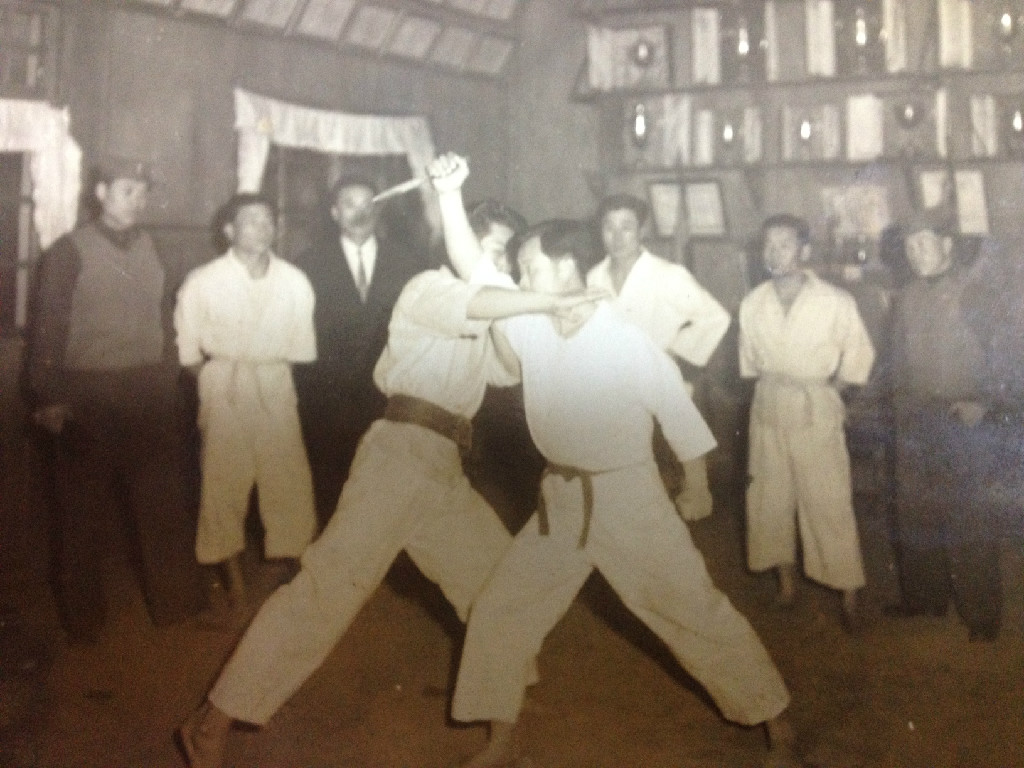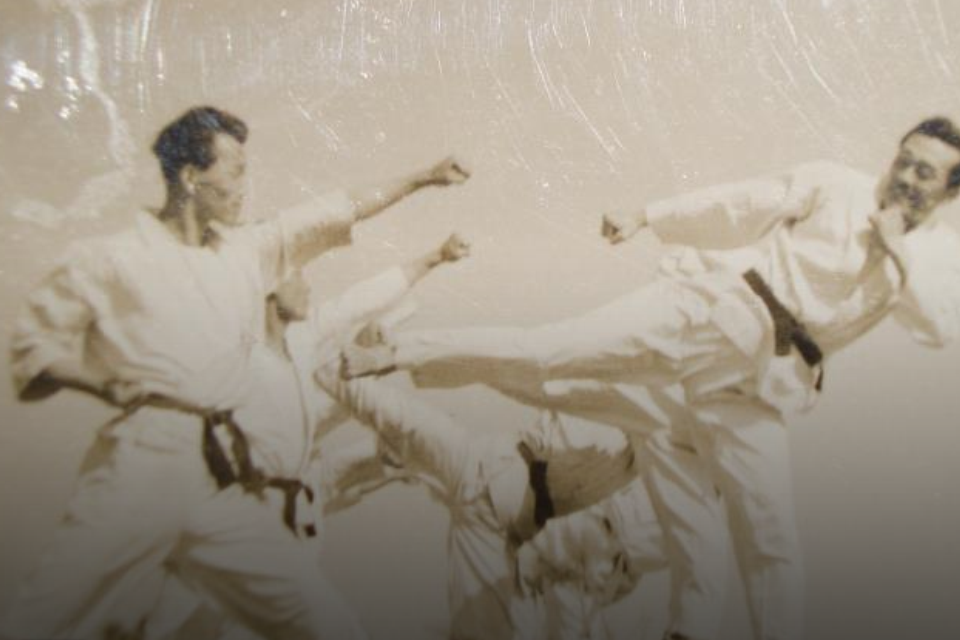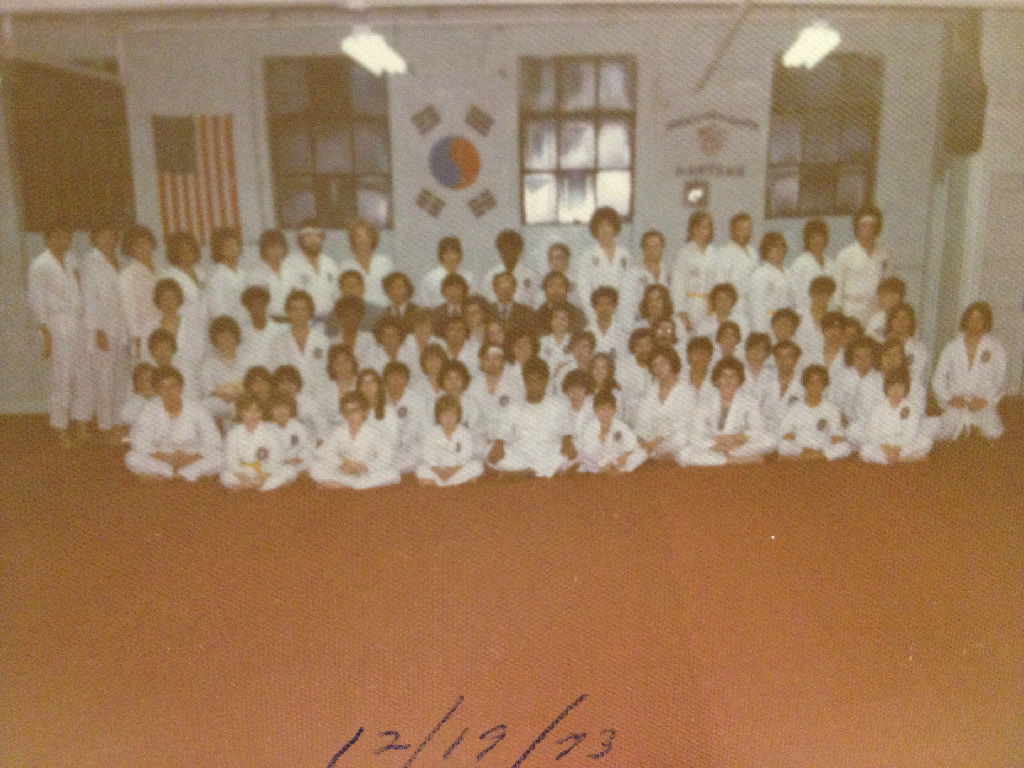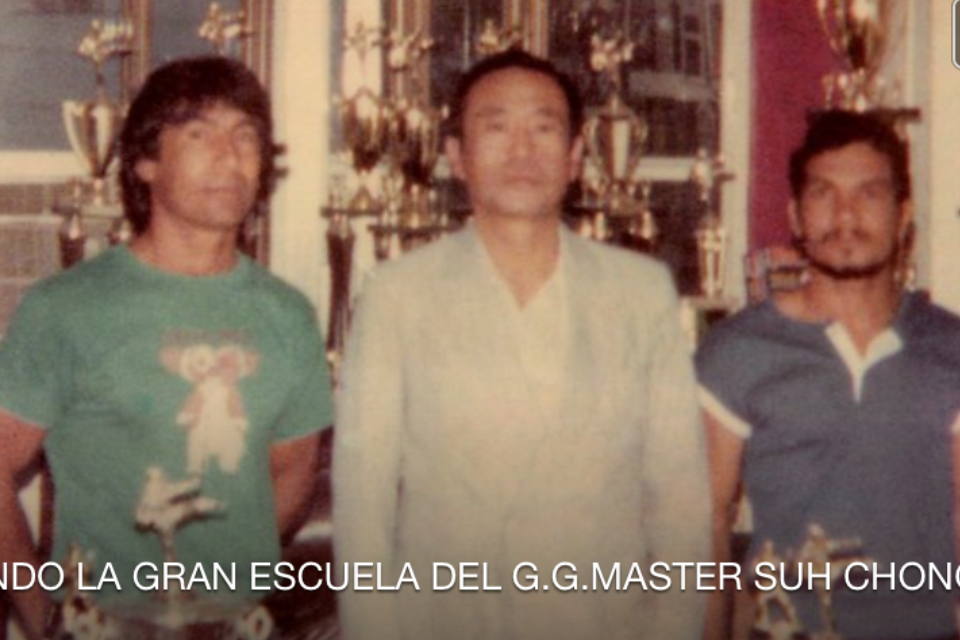The Ultimate fighting Art
INTRODUCTION.
KUK MU KWAN
Welcome to Kuk Mu Kwan's official web site. We are one of the oldest Korean martial arts organizations in the World. Kuk Mu Kwan, founded by our Great Grand Master Suh Chong Kang, on August 10th 1953, represents one of ten originals kwans of Korean martial art. Our founder's philosophy is simple, to teach the most powerful, real to life martial art. Kuk Mu Kwan is a way of life. Kuk Mu Kwan helps us to set our goals higher than others through hard work and commitment. Kuk Mu Kwan masters constantly set standards for practitioners to reach, physical and spiritually, to gain experience and adjust to the next level of practice. Kuk Mu Kwan's curriculum is at a much higher skill level of practice and intelligence than others. Our traditional methods of training and discipline put us at a level higher than sport oriented martial arts.
Kuk Mu Kwan as an unarmed combat, makes great use of hands, feet and rest of the body as a weapon. Our founder, Great Grand Master Suh Chong Kang, knew from experience, that strict discipline and well thought out program of hard training has no substitute. Kuk Mu Kwan training consists of powerful repetitive movements to toughen the body. The system involves skillful application of powerful hand techniques, powerful kicks, jumping, falling, sweeping take downs, throws to neutralize the opponent. Kuk Mu Kwan motions involve circular and linear, to strike and to absorb, with emphasis on proper breathing and control of ki, one's inner energy. Every movement of Kuk Mu Kwan is designed with purpose and result in mind. All techniques of Kuk Mu Kwan are chosen for quickness as well as effectiveness,for use in hand to hand combat.The techniques are not like others because they are purpose chosen, to bring about rapid destruction of opponent or adversary.

Kuk Mu Kwan
Introduction
Welcome to the Kuk Mu Kwan family. In our system, black belts from any martial art styles are welcome as my family member. There are no politics, since I love and respect all martial arts and its founders. Black belts from any system can teach Kuk Mu Kwan, either as the main curriculum or as secondary art form. If you have a passion for practicing and teaching and making good money, getting started is easy, get certified in Kuk Mu Kwan. Being Kuk Mu Kwan certified black belt instructor gives you the rights to teach Kuk Mu Kwan system, that will turn 60 years old in August of 2013. Kuk Mu Kwan is easy to learn and practical to teach, you will enjoy teaching it. Kuk Mu Kwan attracts students of all ages and has a higher retention rate than sport related taekwondo and mixed martial arts, which have limited audiences. Kuk Mu Kwan is practical, fast to learn and has ease of application. Kuk Mu Kwan has quicker turnaround time for exams than other styles of martial arts, 2-months, for color belts and 6-months for black belts levels.

The most powerful martial art of Korea, Kuk Mu Kwan, was founded on August 10, 1953, by the Great Grandmaster Suh Chong Kang. Great Grandmaster began his martial arts training at a very early age of 9. He studied Subakdo and the Japanese sport of Yudo. His background in Yudo, inspired him to try a new art form of Chungdo kwan under the Grandmaster Won Kuk Lee in 1944. Great Grandmaster trained both in Yudo and Chungdo kwan throughout his youth. During this time Korea was occupied by Japan, therefore Chungdo kwan training, was kept under strict secrecy. Grandmaster Won Kuk Lee taught Chungdo kwan to very few students. But in 1949, Grandmaster Won Kuk Lee left for Japan, when he was accused of plotting to assassinate the president. Grandmaster Won Kuk Lee left a junior black belt, named Duk Song Son, who was the oldest student, in charge of Chungdo kwan. This caused a lot of friction among the students of Chungdo kwan, especially for Great Grandmaster Suh Chong Kang, who was the most senior but was the youngest. Great Grandmaster Suh Chong Kang decided not to get into politics on who was going to lead Chungdo kwan, instead he decided to finish his studies at Dong Kuk University, where he was the captain of the martial arts team, and continue his Yudo training. A month after his graduation from Dong Kuk University, Korean War broke out.

During the Korean War, Great Grand Master served the Government well, by leading a student militia, consisting of about 100 college students, armed with bamboo spears. By end of the war, he lost all of the men. Great Grand Master Kang was captured several times by the communists. He escaped by killing his captors, using his powerful kicks and other times by diving off cliffs and other daring maneuvers. Great Grand Master Kang was already well known for his heroism and his fighting skills. Soon after the War, Great Grand Master founded his kwan in Inchon Korea, a port city near the capital of Seoul. Grand Master Son also supported the new kwan, when he stepped down, as the head of Chungdo kwan. Grand Master Son was also criticized for giving an honorary 4th dan to General Choi. Grand Master Son and Great Grand Master Kang became very close friends after the War. Grand Master Son attended all of Kuk Mu Kwan functions and events. After the Korean War, most of the large cities were like the wild west. There were no law and order, just everyone trying to survive as well as they can. Street gangs and Mafia ruled the cities.

Great Grand Master being a young master, were constantly challenged. He never backed down a challenge. At 5’ 10’’ and 180 lbs, black belt in Yudo and Chungdo kwan, he was ready for any confrontation. He said he fought all comers in the streets and bars and won every fight with broken bones and hospitalization for the opponents. In 1955, Great Grand Master was approached by a two star general Choi Hong Hi, who needed a combat instructor for HID (military intelligence facility)/UDT (Seals) in Inchon, and hired him as a private contractor for the Korean government. It was in Inchon, that Great Grand Master refined the art of Kuk Mu Kwan, to include better basics, powerful kicks, self-defense that worked and combat ready sparring techniques that reflected curriculum taught to his HID/UDT agents. It was also here that a lifelong friendship with General Choi Hong Hi began. GGM Kang also taught the Inchon Police force. In 1966 General Choi formed the International TaeKwondo Federation with the support of numerous Korean masters, except Moo Duk Kwan. Great Grand Master Kang supported general Choi with forms and basics and rest of the book was made with the support of his Ohdo kwan students in the Korean Military, who were mostly Chungdo kwan practitioners. General Choi had his personal helicopter at his disposal, and Great Grand Master Kang said that he used it a lot, to pick him up, when he needed help writing his book. Great Grand Master served the Korean government for 11-years.

When Grand master Son got invited to American, by his student to New York, he did not forget his friend, Great Grand master Kang, and invited his whole family to the U.S. in 1969. Grand master Son taught at all of the prestigious Universities in the east coast as well as at West Point. When Grand master Son saw how good Great Grand master Kang was technically and how well he taught class, he felt challenged. So a month after Great Grand master came to the U.S., march of 1969, he was let go. Grand master Son told him not to open a school in Manhattan but a place called Brooklyn, where there were no schools. First, Great Grand master Kang started work as a janitor, in a sailors union building on 7th ave. One day, George Ripol, head of the union building, saw Great Grand master Kang, kicking and punching a heavy bag, which sounded like gunfire. From that day on, Mr. Ripol, told Great Grand master, not to clean, but to teach his sailors what he was doing. Great Grand master taught at the sailors union for about a year before he opened his dojang on 14st and Neck Road, Sheepshead bay section of Brooklyn. Great Grand master’s first students were, Mr Ernest Fears and Jose Rodriguez. Mr. Fears and Mr.Rodriguez were fearsome fighters, they were top competitors at Richard Chun and Henry Cho tournaments, in the late 1960’s and early 1970’s. Three years later, they out grew out of the Neck Road location and moved two blocks away, to a much larger 4,000 sq ft location. Back in Korea, all of the Kuk Mu Kwan dojangs were run by Master/Professor/Author Kim Ho Sung, Great Grand master’s top student in Inchon, Korea. Great Grand master and Master Kim, traveled back and forth to Korea, trying to continue the link between the two Countries.

In 1970, Haeng Ung Lee(left), Great Grand master’s student from Korea, who lived in Little Rock Arkansas, wanted to form the American Taekwondo Association. But, because of his lower rank and no name recognition, Lee asked for help from his master and mentor. Master Haeng Ung Lee and his friend In Mook Kim, wanted Great Grand master Kang to become the president. These were the golden years for Taekwondo and ATA. Great Grand master recruited hundreds of masters from all over U.S., they were the envy of all foreign Taekwondo Associations. Some of the more noted Masters were, Hee IL Cho, Pugill Kwon, BongSoo Han(cousin), Hwang Kwang Sung, He-Young Kimm, Lee Park, Heung Yop Chung and many others. As Taekwondo movement grew in the U.S., in Korea, all the Kwans were in jeopardy, as the Korean government consolidated all the kwans to KTA. KTA under the umbrella of the newly formed World Taekwondo Federation, competition to ITF, wanted their forms and sparring techniques to be taught at all kwans. Any dojangs not following the rules in Korea were threatened to be closed down by the government. Korea wanted to host the 1988 Olympics and thought that too many styles would undermine the push by the Korean government to introduce Taekwondo as a sport. Eventually the KCIA and government got their way by threatening and bullying masters and their families, got introduced as the sport of Taekwondo. In Korea, the signs of past are still evident, with v-neck uniforms and hogu worn for all sparring matches and especially the walking stances, for basics. By 1981, Great Grand master Kang decided to call it quits, when after years of asking for compensation for travel expenses went in deaf years by ATA headquarters, headed by Haeng Ung Lee. When Great Grand master resigned, so did every Korean masters. Today, ATA has no Korean masters in the organization, except for Haeng Ung Lee’s brother, who became president, after Haeng Ung Lee’s death. In 1974, at Young brothers tournament in Pittsburgh, Great Grand master Kang was once again approached by General Choi, to join International Taekwondo Federation, as the vice president.

Great Grand master Kang and General Choi, traveled all over the World to promote ITF. It was in the mid 1980’s when Great Grand master was asked by General Choi to travel to North Korea. General Choi felt threatened by the WTF takeover in South Korea, so he wanted to challenge them by establishing ties with North Korea with the introduction of ITF there. Great Grand master Kang resigned from ITF for personal reasons, left general Choi alone in this political fight with the WTF, which still exists today.

In 1973, Great Grand master Kang was visited by Mr. Jose Moro and Mr. Luis Colon. They wanted their teacher, Mr. Nguen and their dojang in Puerto Rico, to come under the umbrella of Kuk Mu Kwan. When Great Grand master Kang resigned from ATA and ITF, he decided to go it alone and formed ATF. Today it’s called AATF or Kuk Mu Kwan. Great Grand master had most of the east coast masters under ATF as well as Puerto Rico. By 1988, most of the Korean masters left for a more powerful, government run WTF, under the threat of travel restrictions for masters and their families, by the KCIA, traveling in and out of Korea was under scrutiny. If they did not switch to WTF, you were not allowed in Korea. A bit too late, but I was told that, today with democratic government in Korea, once again, kwans are making a comeback.

One thing that remained constant, was the loyalty by the Puerto Rican instructors. When Master Nguen left his Isabela dojang in the mid 1990’s, for California, I was approached by Sahbumnim Ralph Grajales. Sahbumnim Grajales wanted, up to date teaching methods and business consult. It was on December 3rd 1997, that I decided personally to visit the Isabela dojang. First examinees were, Mr. Serrano, Mr. Manuel Rodriguez, Mr. Grajales and Mr. S. Santiago. Today, from a humble beginning, we have two Grandmasters, Grand master Moro and Grand master Colon. Waiting in the wings are future Grand masters, Master Grajales, Master Vega, Master Manuel, Master Serrano, Master Jimenez and Master Luis Rodriguez to name a few.

In New York, the loyalty of Kuk Mu Kwan masters and black belts are continuing. When I opened my first Canarsie dojang in 1987, many of my top black belts followed. Today, my most senior black belt includes Master Moore, Master White, Master Tommy, Master Bernstein and his three sons, Master Kofi, Master Ray, Master Beaujin, Jaime Rodriguez, Nigel and many more. Kuk Mu Kwan still continues to expand, we have sahbumnim Cano in Mayaguez, Sahbumnim Memo in Isabela, Puerto Rico. In New York, Master Maggie, Master Will, Master Jin, Master Kim, Sahbumnim Paul, Sahbumnim Hector and Mr Deblasi have recently joined Kuk Mu Kwan. In the works are numerous international masters wanting membership. In the end, it was never about numbers but quality of black belts, their character and their loyalty, that made Kuk Mu Kwan powerful. Through their dedication and love of the art, made Kuk Mu Kwan known to few serious martial artists. On behalf of My father, Great Grand Master Suh Chong Kang, myself and my Kuk Mu Kwan family thanks you for your continued loyalty, dedication and love, kamsahamnida.
Copyrighted 2012 Kuk Mu Kwan. All rights reserved.

